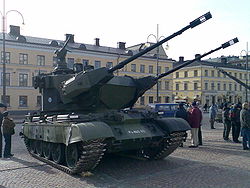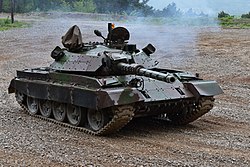| T-54 | |
|---|---|
 T-54-3 at the Parola Tank Museum in Parola, Finland | |
| Type | Medium tank/Main battle tank |
| Place of origin | Soviet Union |
| Service history | |
| In service | 1947–present |
| Production history | |
| Designer | Morozov (T-54), OKB-520 (T-54A and later) |
| Designed | 1945 |
| Manufacturer | KhPZ, UVZ (USSR), Bumar-Łabędy (Poland), ZTS Martin (Slovakia) |
| Produced | 1946–81 (USSR) 1956–79 (Poland) 1957–83 (Slovakia) |
| No. built | 96,000–100,000 est. |
The T-54/T-55 tank series is the most widely used tank in the world and has seen service in over 50 countries. It has also served as the platform for a wide variety of specialty armoured vehicles. [1] [2]













































